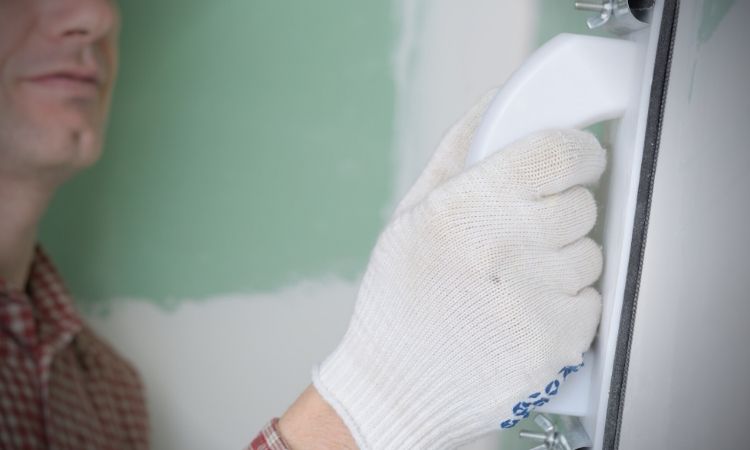A perfect job has to be done with a perfect tool, and that is why finishing sanders are important in the construction and finishing process. This type of sander is used to provide a smooth surface on different materials like wood, plastic, metal, etc.
A finishing sander is a versatile tool that is used for giving a fine finishing touch to wood projects. It can be used for various purposes such as smoothing, working on square corners, sanding mouldings, carvings, and other differently shaped surfaces, taking out bigger scratches as a last step in finishing, preparing a surface for painting, and sanding in between coats of paint or finish.
If you need to get something done as quickly as possible, we recommend that you use a finishing sander. Many people believe that a palm sander can substitute for a finishing sander, but this is not the case because palm sanders are designed for greater jobs and do not provide good finishes like finishing sanders.
Now, Let’s Talk About What Is a Finishing Sander Used For?
As we said earlier, this type of sander is used to provide a smooth surface, but it can also be used for other purposes. For example, you can use it to remove paint from surfaces or varnish.
You can also use it to fix any irregularities on the surface of the wood. If you have small indentations or scratches, you can use a finishing sander to make them disappear.
Furthermore, if you are working with small pieces of wood,] it is better to use a finishing sander instead of a palm sander because the former will provide you with better results.
What Is Grit How It Can Be Used?
The grit is the size of the abrasive particles on the sandpaper. The higher the number, the finer the grain. For example, the 30-grit paper has large grains while 400-grit paper has very fine grains.
You should use different grits depending on the material you are working with and the type of surface you want to achieve.
If you are working with hardwood, you should start with a coarse grit (40 or 60) and then move to a finer one.
On the other hand, if you are working with softwood, you can start with a medium-grit paper (100).
In general, the following grit order is recommended:
- 60/80/100/120/150/180/220
- 240/280/320/360/400

How To Use A Finishing Sander?
Using a finishing sander is as like as using a palm sander. The main difference is that finishing sanders are smaller and have a rectangular base.
Step-1: Choose the Right Sandpaper
As we said before, the grit you need depends on the material you are working with and the surface you want to achieve. So, make sure to choose the right sandpaper before starting your work. If you’re not the pro level worker then you must go for the professional help.
Step-2: Prepare the Surface
Before using the sander, you need to prepare the surface. For example, if you are going to remove paint from a wood surface, you need to sand it first with coarse-grit paper to remove the paint and then use a finer grit to smooth the surface.
If you are going to stain the wood, you need to sand it with a fine-grit paper to make sure the stain will be even.
Step-3: Turn on the Sander and Start Sanding
Once you have chosen the right sandpaper and prepared the surface, you can turn on the sander and start working.
Remember to move the sander in different directions to avoid creating scratches or uneven surfaces.
Also, make sure to apply even pressure on the sander and don’t push too hard because you could damage the surface.
Step-4: Check the Surface Regularly
As you are sanding, check the surface regularly to see if you are achieving the desired results. If not, you can change the sandpaper or adjust your technique.
Step-5: Clean the Surface
When you are finished sanding, make sure to clean the surface to remove any dust or debris. You can use a vacuum cleaner or a damp cloth. You should also clean the sander to remove any sandpaper residue.
How to Finish Sanding like a Pro- Sanding Tips?
Achieving a professional finish through sanding requires attention to detail and the application of effective techniques. Start by selecting the appropriate grit of sandpaper based on your project needs, beginning with a coarser grit for material removal and progressively moving to finer grits for a smoother finish. Ensure the surface is clean and free of dust before you start sanding.
Use long, even strokes, moving with the grain of the wood to prevent scratches. When using an orbital sander, let the tool do the work; there’s no need to apply excessive pressure. For hand sanding, fold the sandpaper to create a firm but flexible surface.
Periodically check your progress by running your hand over the surface to feel for any imperfections. Pay extra attention to edges and corners to maintain consistency. Utilize proper safety gear, including a mask and goggles, to protect yourself from dust.
Finally, if staining or painting, consider using a pre-stain wood conditioner for an even and professional-looking finish. Taking the time to follow these sanding tips will contribute to a polished and professional outcome in your woodworking or refinishing projects.
Is There Any Other Use of Finishing Sander?
Yes, finishing sanders have many other uses besides sanding wood.
For example, you can use them to remove paint from a wall or ceiling, to sand down plaster, or to remove rust from metal surfaces. Besides, you can also use them to create a smooth finish on concrete or stone surfaces.
Another use of finishing sander is to remove varnish from wood. This is a common technique used by furniture refinishes.
To do this, you need to sand the surface with a coarse-grit paper to remove the varnish and then use a finer grit to smooth the surface.
You can also use a finishing sander to remove wax from a wood floor.
Should I Concern Before Buying A Finishing Sander?
Yes, you should concern before buying a finishing sander because it’s a one-time investment. There are many things to consider before purchasing a finishing sander such as the type of sander, the size, the power, the price, and the warranty.
Read Our Best Finishing Sander Fro Your Projects.
FAQ:
What is a finishing sander used for?
A1: A finishing sander, also known as a palm sander or detail sander, is used for fine sanding and smoothing surfaces, especially in woodworking and finishing projects. It is ideal for removing small imperfections, leveling surfaces, and preparing them for final finishes like paint or stain.
Q2: Can a finishing sander be used for material removal?
A2: While a finishing sander is primarily designed for light sanding and finishing touches, it is not the best choice for heavy material removal. For substantial material removal, a coarser sander like a belt sander or an orbital sander would be more suitable.
Q3: What types of projects benefit from a finishing sander?
A3: Finishing sanders are excellent for projects that require precision and a smooth, refined finish. They are commonly used for finishing furniture, cabinets, trim work, and other woodworking tasks where a fine, polished surface is desired.
Q4: Can a finishing sander be used on curved surfaces?
A4: Yes, finishing sanders are versatile enough to be used on curved surfaces. Their compact size and ability to reach into corners make them well-suited for intricate detailing and curved contours. This makes them an excellent choice for projects with rounded or contoured elements.
Q5: How does a finishing sander differ from other sanders?
A5: Unlike more aggressive sanders such as belt sanders or orbital sanders, a finishing sander is characterized by its smaller size, lightweight design, and finer sanding action. It excels at providing a delicate touch for final smoothing and finishing work, offering precision and control in detail-oriented tasks.
Conclusion:
Whether you’re a beginner or a professional, using a finishing sander is a great way to achieve a smooth surface.
Just remember to choose the right sandpaper, to prepare the surface, and to sand in different directions. Also, don’t forget to clean the surface and the sander when you’re finished.
If you follow these tips, you’ll be able to sand like a pro in no time!
Now that you know how to use a finishing sander, why not try it on your next project?

I am a graduate of Bangladesh Agricultural University, where I delved into various agricultural disciplines, equipping me with a profound understanding of agriculture. Beyond academics, I have hands-on experience in gardening and crop cultivation. My passion is to embrace sustainable farming and horticulture. With a BSc in Agriculture, I am dedicated to promoting environmentally conscious and efficient agrarian practices.
Bachelor of Science (BSc) in Agriculture (Hons.)
Master of Science. (Sustainable Agriculture & Food Security ) (MS)
Bangladesh Agricultural University



